Dodge Journey: Valves, intake and exhaust
Description
The valves are made of heat resistant steel, and have chrome plated stems to prevent scuffing. The four valves per cylinder (two intake and two exhaust) are actuated by roller rocker arms, which pivot on stationary lash adjusters. All valves use three bead lock keepers to retain springs and to promote valve rotation.
Standard Procedure
VALVE AND VALVE SEAT REFACING
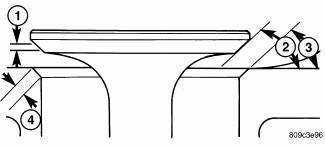
Fig. 152: Valve Face & Seat
- - SEAT WIDTH
- - FACE ANGLE
- - SEAT ANGLE
- - SEAT CONTACT AREA
The intake and exhaust valves have a 44.5 to 45 degree face angle (2). The valve seats have a 45 to 45.5 degree face angle (3).
VALVES
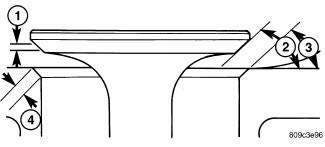
Fig. 153: Valve Face & Seat
- - SEAT WIDTH
- - FACE ANGLE
- - SEAT ANGLE
- - SEAT CONTACT AREA
Inspect the remaining margin after the valves are refaced.
VALVE SEATS
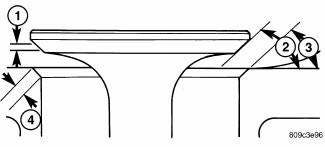
Fig. 154: Valve Face & Seat
- - SEAT WIDTH
- - FACE ANGLE
- - SEAT ANGLE
- - SEAT CONTACT AREA
1. When refacing valve seats, it is important that the correct size valve guide pilot be used for reseating stones. A true and complete surface must be obtained.
2. Measure the concentricity of valve seat using dial indicator. Total runout should not exceed 0.051 mm (0.002 inch.) total indicator reading.
3. Inspect the valve seat with Prussian blue to determine where the valve contacts the seat. To do this, coat valve seat LIGHTLY with Prussian blue then set valve in place. Rotate the valve with light pressure. If the blue is transferred to the center of valve face, contact is satisfactory. If the blue is transferred to top edge of valve face, then lower valve seat with a 15 degree stone. If the blue is transferred to the bottom edge of valve face, then raise valve seat with a 65 degree stone.
NOTE: Valve seats which are worn or burned can be reworked, provided that correct angle and seat width are maintained. Otherwise cylinder head must be replaced.
4. When seat is properly positioned the width of the intake 1.00 to 1.50 mm (0.0394 to 0.0591 in.) and exhaust seats should be 1.25 to 1.75 mm (0.049 to 0.069 in.).
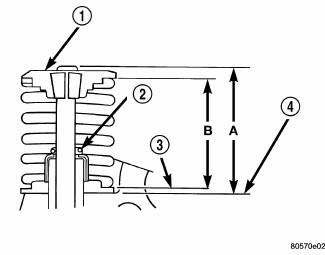
Fig. 155: Valve Tip Height & Valve Spring Installed Height
- - SPRING RETAINER
- - GARTER SPRING
- - VALVE SPRING SEAT TOP
- - CYLINDER HEAD SURFACE
5. Check the valve spring installed height after refacing the valve and seat.
VALVE AND SPRING INSTALLED HEIGHT
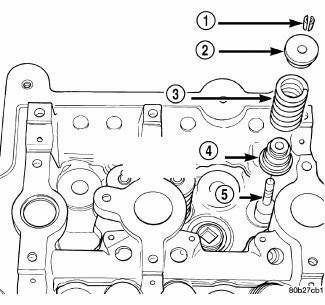
Fig. 156: Valve Seal & Spring
- - VALVE RETAINING LOCKS
- - VALVE SPRING RETAINER
- - VALVE SPRING
- - VALVE SEAL AND VALVE SPRING SEAT ASSEMBLY
- - VALVE
1. Coat valve stems with clean engine oil and insert them in cylinder head.
2. If valves (5) or seats have been refaced, check valve tip height (A). If valve tip height for intake valve is greater than 47.59 (1.8737 in.) or 49.14 (1.9347 in.) for exhaust valve, grind valve tip until within specifications. Make sure measurement is taken from cylinder head surface to the top of valve stem.
3. Install valve seal/spring seat assembly over valve guides on all valve stems. Ensure that the garter spring is intact around the top of the rubber seal.
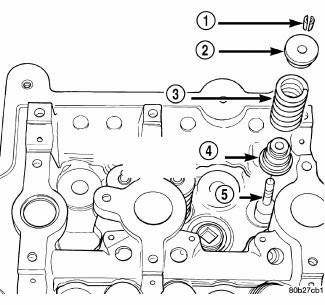
Fig. 157: Valve Seal & Spring
- - VALVE RETAINING LOCKS
- - VALVE SPRING RETAINER
- - VALVE SPRING
- - VALVE SEAL AND VALVE SPRING SEAT ASSEMBLY
- - VALVE
4. Position valve springs (3) and retainer on spring seat.
5. Compress valve spring with a valve spring compressor.
6. Install retainer locks and release tool.
7. If valves and/or seats are refaced, measure the installed height of springs (B). Measurement is taken from top of spring seat to the bottom surface of spring retainer. If height is greater than 38.75 mm (1.5256 in.), install a 0.762 mm (0.030 in.) spacer in head counterbore under the valve spring seat to bring spring height back within specification.
Removal
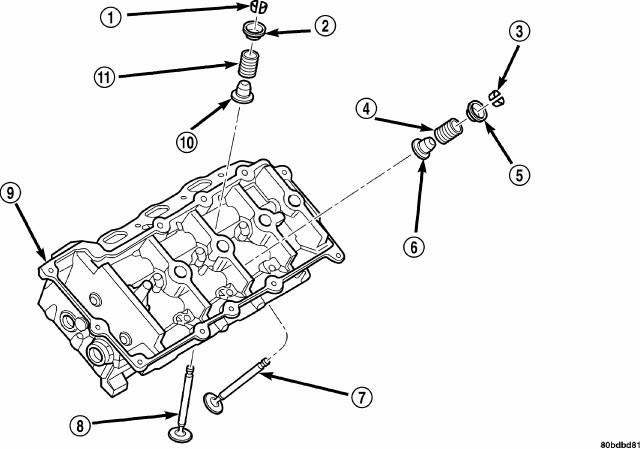
Fig. 158: Cylinder Head, Valves & Springs
- - VALVE KEEPER
- - SPRING RETAINER
- - VALVE KEEPER
- - VALVE SPRING-EXHAUST
- - SPRING RETAINER
- - VALVE STEM SEAL
- - VALVE-EXHAUST
- - VALVE-INTAKE
- - CYLINDER HEAD
- - VALVE STEM SEAL
- - VALVE SPRING-INTAKE
1. Remove cylinder head(s).
2. Remove valve spring.
3. Before removing valves, remove any burrs from valve stem lock grooves to prevent damage to the valve guides.
4. Remove valve (7). Identify each valve to ensure installation in original location.
Inspection
VALVES
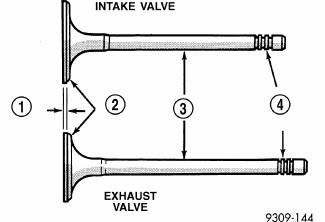
Fig. 159: Intake & Exhaust Valves
- - MARGIN
- - FACE
- - STEM
- - VALVE SPRING RETAINER LOCK GROOVES
1. Clean and inspect valves thoroughly. Replace burned, warped and cracked valves.
2. Measure valve stems for wear (3).
NOTE: Valve stems are chrome plated and should not be polished.
VALVE GUIDES
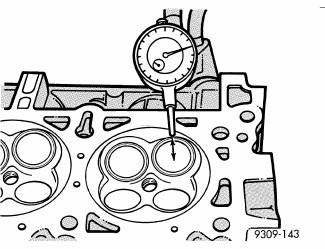
Fig. 160: Measuring Valve Guide Wear - Typical
1. Remove carbon and varnish deposits from inside of valve guides with a reliable guide cleaner.
2. Measure valve stem-to-guide clearance as follows:
3. Install valve into cylinder head so it is 15 mm (0.590 inch.) off the valve seat. A small piece of hose may be used to hold valve in place.
4. Attach dial indicator Tool C-3339A to cylinder head and set it at right angle of valve stem being measured.
5. Move valve to and from the indicator.
NOTE: Replace cylinder head if stem-to-guide clearance exceeds specifications, or if guide is loose in cylinder head.
Installation
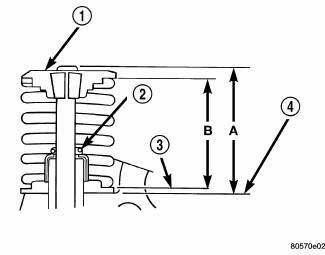
Fig. 161: Valve Tip Height & Valve Spring Installed Height
- - SPRING RETAINER
- - GARTER SPRING
- - VALVE SPRING SEAT TOP
- - CYLINDER HEAD SURFACE
1. Coat valve stems with clean engine oil and insert them in cylinder head.
2. If valves or seats have been re-ground, check valve tip height (A). If valve tip height for intake valve is greater than 47.59 mm (1.8737 in.) or 49.14 mm (1.9347 in.) for exhaust valve, grind valve tip until within specifications. Make sure measurement is taken from cylinder head surface to the top of valve stem.
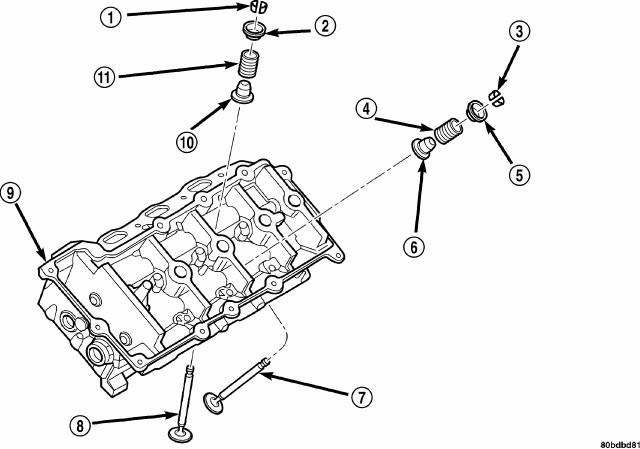
Fig. 162: Cylinder Head, Valves & Springs
- - VALVE KEEPER
- - SPRING RETAINER
- - VALVE KEEPER
- - VALVE SPRING-EXHAUST
- - SPRING RETAINER
- - VALVE STEM SEAL
- - VALVE-EXHAUST
- - VALVE-INTAKE
- - CYLINDER HEAD
- - VALVE STEM SEAL
- - VALVE SPRING-INTAKE
3. Install valve spring (4).
 Spring(s), valve
Spring(s), valve
Description
The valve springs are made from high strength, chrome-silicon steel. The
springs are common for intake and
exhaust applications. The valve spring seat is integral with the valve stem
...
 Engine block
Engine block
...
See also:
Description
Fig. 1: Exterior Lighting System
The exterior lighting system for this vehicle includes the following exterior
lamp units:
Center High Mounted Stop Lamp (3) - A standard equipment Center High ...
Module, steering column
DESCRIPTION
Fig. 47: Steering Control Module
This vehicle is equipped with a Steering Control Module (SCM) that is
internal to the left multi-function switch
housing (2). The left (lighting) mu ...
Removal
LEFT-HAND-DRIVE
1. Disconnect and isolate the battery negative cable from its post on the
battery.
2. If equipped, remove the silencer pad below the steering column opening cover.
Fig. 132: S ...
